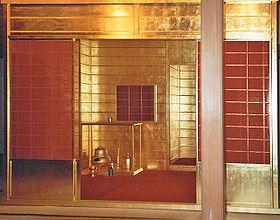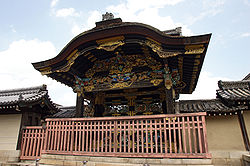
Fushimi Castle
Encyclopedia
, also known as Momoyama Castle (桃山城 Momoyama-jō) or Fushimi-Momoyama Castle, is a castle
in Kyoto's Fushimi Ward
. The current structure is a 1964 replica of the original built by Toyotomi Hideyoshi
.
 The construction of the original castle was begun in 1592, the year after Hideyoshi's retirement from the regency
The construction of the original castle was begun in 1592, the year after Hideyoshi's retirement from the regency
, and completed in 1594. Twenty provinces
furnished workers for the construction, which numbered between 20,000 and 30,000.
Though bearing the external martial appearance of a castle, the structure was intended as a retirement palace for Hideyoshi, and was furnished and decorated as such. It is particularly famous for its tea ceremony
room in which both the walls and the implements were covered in gold leaf
. The castle was intended to be the site for Hideyoshi's peace talks with Chinese diplomats seeking an end to the Seven-Year War in Korea
, but an earthquake destroyed the castle entirely only two years after its completion.
It was rebuilt soon afterwards, and came to be controlled by Torii Mototada
, a vassal of Tokugawa Ieyasu
. In 1600, the castle fell in a famous and significant siege
by Ishida Mitsunari
. Torii Mototada
, in a celebrated act of honor and bravery, defended the castle for eleven days, delaying Ishida's forces and allowing his lord Tokugawa time to build his own army. This had a profound effect on the Battle of Sekigahara
, which came soon afterwards, and which marked the final victory of Tokugawa Ieyasu over all his rivals.
 In 1623, the castle was dismantled, and many of its rooms and buildings were incorporated into castles and temples across Japan. A temple in Kyoto, Yōgen-in (養源院), has a blood-stained ceiling that had been the floor of a corridor at Fushimi Castle where Torii Mototada
In 1623, the castle was dismantled, and many of its rooms and buildings were incorporated into castles and temples across Japan. A temple in Kyoto, Yōgen-in (養源院), has a blood-stained ceiling that had been the floor of a corridor at Fushimi Castle where Torii Mototada
and company had committed suicide.
In 1912, the tomb of Emperor Meiji
was built on the original site of the castle. The castle was not rebuilt until 1964, when a replica was created very nearby and primarily in concrete. The new structure served as a museum of the life and campaigns of Toyotomi Hideyoshi, but was closed to the public in 2003.
Japanese castle
' were fortresses composed primarily of wood and stone. They evolved from the wooden stockades of earlier centuries, and came into their best-known form in the 16th century...
in Kyoto's Fushimi Ward
Wards of Japan
A is a subdivision of one of the cities of Japan that is large enough to have been designated by government ordinance. Wards are used to subdivide each city designated by government ordinance...
. The current structure is a 1964 replica of the original built by Toyotomi Hideyoshi
Toyotomi Hideyoshi
was a daimyo warrior, general and politician of the Sengoku period. He unified the political factions of Japan. He succeeded his former liege lord, Oda Nobunaga, and brought an end to the Sengoku period. The period of his rule is often called the Momoyama period, named after Hideyoshi's castle...
.
History

Sessho and Kampaku
In Japan, was a title given to a regent who was named to assist either a child emperor before his coming of age, or an empress. The was theoretically a sort of chief advisor for the emperor, but was the title of both first secretary and regent who assists an adult emperor. During the Heian era,...
, and completed in 1594. Twenty provinces
Provinces of Japan
Before the modern prefecture system was established, the land of Japan was divided into tens of kuni , usually known in English as provinces. Each province was divided into gun ....
furnished workers for the construction, which numbered between 20,000 and 30,000.
Though bearing the external martial appearance of a castle, the structure was intended as a retirement palace for Hideyoshi, and was furnished and decorated as such. It is particularly famous for its tea ceremony
Japanese tea ceremony
The Japanese tea ceremony, also called the Way of Tea, is a Japanese cultural activity involving the ceremonial preparation and presentation of matcha, powdered green tea. In Japanese, it is called . The manner in which it is performed, or the art of its performance, is called...
room in which both the walls and the implements were covered in gold leaf
Gold leaf
right|thumb|250px|[[Burnishing]] gold leaf with an [[agate]] stone tool, during the water gilding processGold leaf is gold that has been hammered into extremely thin sheets and is often used for gilding. Gold leaf is available in a wide variety of karats and shades...
. The castle was intended to be the site for Hideyoshi's peace talks with Chinese diplomats seeking an end to the Seven-Year War in Korea
Korea
Korea ) is an East Asian geographic region that is currently divided into two separate sovereign states — North Korea and South Korea. Located on the Korean Peninsula, Korea is bordered by the People's Republic of China to the northwest, Russia to the northeast, and is separated from Japan to the...
, but an earthquake destroyed the castle entirely only two years after its completion.
It was rebuilt soon afterwards, and came to be controlled by Torii Mototada
Torii Mototada
was a Japanese samurai of the Sengoku period through late Azuchi-Momoyama Period, who served Tokugawa Ieyasu. Torii died at the siege of Fushimi where his garrison was greatly outnumbered and destroyed by the army of Ishida Mitsunari...
, a vassal of Tokugawa Ieyasu
Tokugawa Ieyasu
was the founder and first shogun of the Tokugawa shogunate of Japan , which ruled from the Battle of Sekigahara in 1600 until the Meiji Restoration in 1868. Ieyasu seized power in 1600, received appointment as shogun in 1603, abdicated from office in 1605, but...
. In 1600, the castle fell in a famous and significant siege
Siege of Fushimi
The siege of Fushimi was a crucial battle in the series leading up to the decisive battle of Sekigahara which ended Japan's Sengoku period. Fushimi Castle was defended by a force loyal to Tokugawa Ieyasu's Eastern army, led by Torii Mototada...
by Ishida Mitsunari
Ishida Mitsunari
Ishida Mitsunari was a samurai who led the Western army in the Battle of Sekigahara following the Azuchi-Momoyama period of the 17th century. Also known by his court title, Jibunoshō...
. Torii Mototada
Torii Mototada
was a Japanese samurai of the Sengoku period through late Azuchi-Momoyama Period, who served Tokugawa Ieyasu. Torii died at the siege of Fushimi where his garrison was greatly outnumbered and destroyed by the army of Ishida Mitsunari...
, in a celebrated act of honor and bravery, defended the castle for eleven days, delaying Ishida's forces and allowing his lord Tokugawa time to build his own army. This had a profound effect on the Battle of Sekigahara
Battle of Sekigahara
The , popularly known as the , was a decisive battle on October 21, 1600 which cleared the path to the Shogunate for Tokugawa Ieyasu...
, which came soon afterwards, and which marked the final victory of Tokugawa Ieyasu over all his rivals.

Torii Mototada
was a Japanese samurai of the Sengoku period through late Azuchi-Momoyama Period, who served Tokugawa Ieyasu. Torii died at the siege of Fushimi where his garrison was greatly outnumbered and destroyed by the army of Ishida Mitsunari...
and company had committed suicide.
In 1912, the tomb of Emperor Meiji
Emperor Meiji
The or was the 122nd emperor of Japan according to the traditional order of succession, reigning from 3 February 1867 until his death...
was built on the original site of the castle. The castle was not rebuilt until 1964, when a replica was created very nearby and primarily in concrete. The new structure served as a museum of the life and campaigns of Toyotomi Hideyoshi, but was closed to the public in 2003.
External links
- SengokuDaimyo.com : The website of Samurai Author and Historian Anthony J. BryantAnthony J. Bryant-Biography:Anthony J. Bryant is the author of four books for Osprey Military Publishing on samurai history. He is an historian of Japan specializing in Kamakura, Muromachi, and Momoyama period warrior culture. His areas of interest also include Heian-period court structure and society and Japanese...
. Accessed 4 April 2011.

